Collected and posted by Oconto County WIGenWeb Project
Collected and posted by BILL
This site is exclusively for the free access of individual researchers.
* No profit may be made by any person, business or organization through publication, reproduction, presentation or links
to this site
Written by Marie Darrow
Compositor - Ben Penkivich, for the Gillett Public Library
Scanned and contributed by Jennifer Bumann
Family Site Researching Oconto County surnames
JOHN, DEADRICH, CAIN and ROSA
GOVERNMENT AND BUSINESS
In 1854 this vicinity was part of the Town of Stiles. The community took the name of Gillett for their city when it was chartered by the State of Wisconsin on May 10, 1944. Around 1868 the boundaries of the town were expanded to include the areas known as Oconto Falls, Gillett, Underbill, Maple Valley and How; named the Town of Gillett, thus honoring Rodney Gillett.
The first election was held April 7, 1868 in the schoolhouse. Rodney Gillett was elected chairman; Charles Bagley and Charles McKenzie, supervisors; James McPherson, clerk; William John, treasurer; John Volk, D. S. Perrigo and George Hodgins, Justices of the peace; Richard Johnson, George Howell, and James McPherson, constables; Charles Bagley, assessor; and Levi Linsey, Inspector of Weights and Scales.
The Village of Gillett was incorporated in 1900 with
a population of about 400. Although the downtown area of Gillett was
platted
in 1884, it continued to be just a settlement, a part of the Town of
Gillett
until the turn of the century when it was incorporated into a Village.
The first Village officers were: L.J. Newald, president; J. Sore risen,
clerk; and Bans Lykke, treasurer; the first trustees were I.H.
Issaakson,
Oscar Carlson, J.M. Melchior, R.A. Miniely, G.H. Sohr, and August
Foelker.
Records were loosely kept. Mr. Miniely was an officer in the community
for many years but he never was a citizen of the U. S. He had moved
here
from Canada.
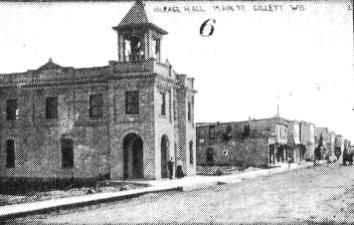
NEW VILLAGE HALL
(Page 11)
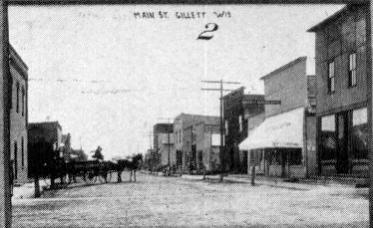
Scenes on Main Street
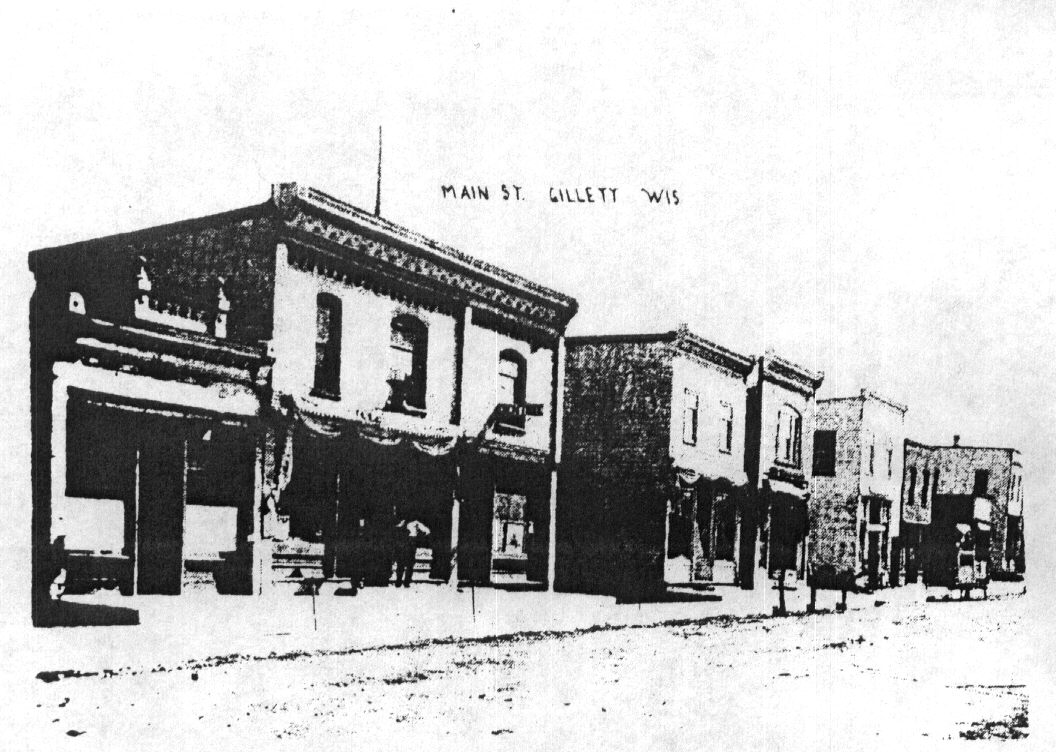
(Page 12)
Between 1884 when Gillett was platted, and 1900 when it was Incorporated, there was a rapid growth with many new businesses and Industries being started. This was partly because a railroad line now connected Gillett and Oconto. Stores, saloons, a cheese factory, a butcher shop, a brickyard, and a barbershop were started. The Gillett Times, a weekly newspaper, was started by L. P. Perry, owner and editor. L. B. Stuelke opened a drugstore, the first in the community, and one year later, In 1901, L. J. Newald started the first bank in the building directly west of Mr. Stuelke's drugstore. This is the small building still standing next to the Laundromat.
Part of the building now used as a Laundromat was built by Jerome Clark in about 1890 and was used as a general store until 1900 when L. B. Stuelke established the first drug store here. Part of the building occupied by Pulcifer Hardware was built by George Sohr in 1893 and was the first hardware store in the community.
The business area extended for two blocks, with the corner of Main Street and Lake Street as the center. The railroad had been built from Oconto to Underhill, and the depot was a fine building at the North end of Main Street. South from the depot, Nick Henter had a tavern on the site of the present Sportsman's Bar. There was only one other building on the north side of main street east of the corner and that building is still there though it underwent considerable remodeling through the years. It was a general store owned by a Mr. Dyer, and was later Shier's Paint Store.
Gillett was well supplied with taverns for the southeast corner of Main and Lake belonged to a Mr. Buche from Cecil who quenched the thirst of the customers while they waited to have their horses shod or their wagon repaired, here was a restaurant east of Mr. Buches tavern in the building that was later moved to Lake Street. Shortly after 1900 this restaurant was operated by William Ehlers, and his aunt Mrs. DeCaster. There was a busy establishment east of the restaurant occupying several buildings. Matt Lang was the wagon maker and Matt Wagner was the blacksmith who together owned a storage barn for completed wagons, buggies and harnesses. There was a small general store where Kuehls Furniture Store now stands which was owned by Charlie Munson. He sold to a Mr. John Wranowskl, who in turn sold to Frank Fowlker. Mr. Foelker established a furniture and undertaking business there and hired Joe Kuehl to run the business. Joe later married Frank Foelker's daughter Hilda.
On the northwest corner of Lake Street and Main there was an imposing two story frame structure, Gilletts first hotel, owned and operated by William John and his wife Olive.
Back once
more to the corner
of Lake and Main Street, this time to the southwest corner, now Robert
Quade's corner, where there was a two story frame structure housing
Louis
Runkel's General Merchandise on the first floor and providing a hall
for
dances and parties on the second floor. Mr. Runkel sold his business to
a Mr. Schnddt and George Grotelueschen. Mr. Grotelueschen sold his
share
of the business to L. J. Newald, who later became Gillett's first
banker,
but this transaction made Mr. Schnidt quite unhappy so he refused to
allow
Mr. Newald to enter the building. Mr. Newald went across the street to
the tavern, purchased a double headed beer keg and threw it through the
locked door.
(Page 13)
Soon the reluctant.partners sold out
to Mr. Groteluschen,
and his father-in-law, Mr. Savage. They enjoyed many prosperous years,
and later tore down the old store and built the brick building now
owned
by Robert Quade.
The McKenzie residence west of the big store was situated where Midtown restaurant is now. John Watt's store was at the end of the block in the area of the Sunrise Cafe. Mr. Watt did a big business with the Pottawatami Indians who rode in on horseback or walked in from their settlement where the Herman Giese farm is, many of the women with their papooses strapped to their backs. Often they camped over night on the corner now occupied by the library.
In the early years of the 20th century a plant named The Gillett Woodenware was built where the Gillett Plywood and Veneer is located now. Mr. John Smith father of W. W. Smith, built the plant and moved his machinery in from Seymour, entirely by team and wagon. It is reported that John Bex, who helped move the machinery, would ride to Seymour, load the machinery, and then walk back home. The Woodenware Co. manufactured early pails, and for a short time, made cheese boxes. The original mill burned about in 1913, but was rebuilt and named The Great Northern Pail Company, and was owned by a Mr. J. P. Smith from Green Bay who was no relation to John Smith. Walter W. Smith was manager of the factory. The old "pail factory" was forced to close down early in the great depression and was later sold to the Baldwin family of Appleton who operated it as a Veneer Factory. It was sold by Baldwins to its present owners.
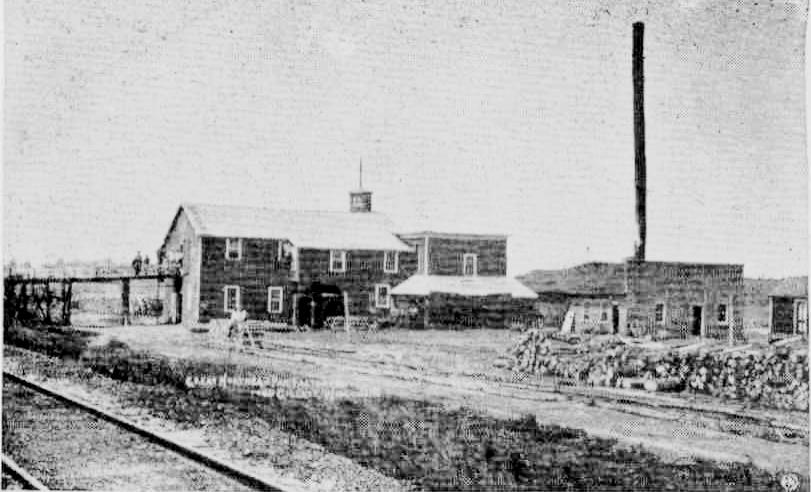
The Great Northern
Pail Company
The earliest canning factory was built by a
man
named Waters. Financial difficulties brought
H. H. (note: F.F.)
Koske, who then was the banker in Gillett, into it. He financed nearly
all of the operation, bringing in Hans Sorenson, George Hoxle, Joe
Norick.
Fred Larson, and others. Later Mans Sorenson became President and rick
became Factory Superintendent. Today it is one factory operated by the
Friday Canning Co.
(Page 14)
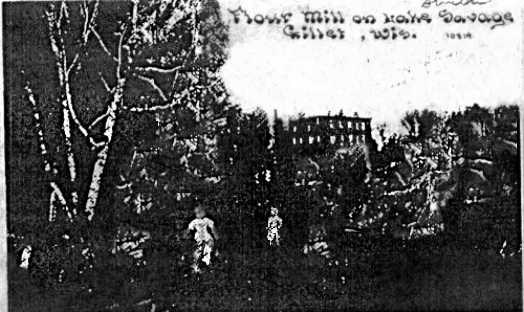
(note: Faint handwriting at the
top right appears to read; "Florence Stuelke Isabel
Reidman")
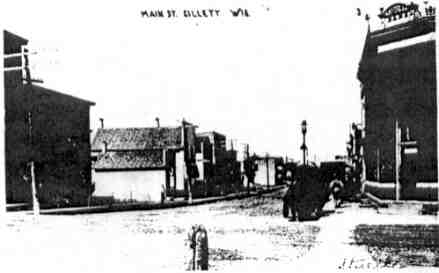
Main St.
Gillett, Wis.
History of Gillett Table of Contents Page